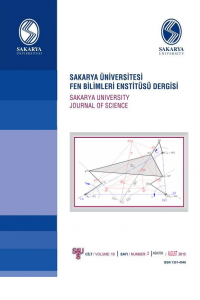Abstract
Fluorescent and LED lamps are the most common used light sources both in homes and offices due to their low energy consumptions. However both sources are short of the quality of power factor, harmonic components and colour rendering. Taking these parameters in account, the purpose of this study is to investigate and compare energy quality parameters for different light sources used with lighting control, especially dimming control. To that end, energy quality parameters as harmonic current values, total harmonic distortion and power factor of LED and fluorescent lamps in lighting control, under different scenarios and dimming are measured, analysed and suggestions made to evade the disruptive effects both on electricity network and local lighting control system.
References
- -
- Chartered Institute of Building Service Engineers, Guide F: Energy efficiency in buildings, 1999.
- M. Krarti, “Energy audit of building systems: An engineering approach”, Boca Raton, FL: CRC Press, 2000.
- National Resources Canada (NRC), Commercial / Institutional secondary energy use by energy source, end use and activity, Canada, 2000.
- P. Bertoldi, C.N. Ciugudeanu, Five Year Report of the European Greenlight Programme, EUR 21648 EN, European Commission, DG JRC, Institute for Environment and Sustainability, Renewable Energies Unit, 2005. [6] IEC
- Compatibility, Part 3, Section 2, Limits for [10]
- Harmonic Current Emissions (Equipment Input Current ≤16 A per Phase), ed. 3; International Electrotechnical Commission (IEC), Switzerland, 2011. IEC
- Compatibility (EMC), Testing and Measurement Techniques, General Guide on Harmonics and Interharmonics
- Instrumentation, for Power Supply Systems and Equipment Connected Thereto; International [12]
- Electrotechnical Commission, Switzerland, 2002. Voltage Characteristics in Public Distribution Systems, EN 50160; CENELEC, Belgium, 1999. International Energy Agency, Daylight in buildings a source book on daylighting systems and components, A Report of IEA SHC Task 21/ECBCS Annex 29, 2000.
- Electromagnetic [7] EN 61000-4-7:
- Electromagnetic [11] Measurements and [8] [9]
- C. Yavuz, E.Yanıkoğlu, Ö. Güler, “Evaluation of Daylight Responsive Lighting Control Systems According to the Results of a Long Term Experiment”, Light & Engineering Journal, 20(4), pp. 75-83, 2012
- L.Tug, C.Yavuz, “Reduction of the Effects of Current Harmonics in Low Voltage Systems”, 1st International
- Technologies in Engineering and Science, Sakarya, Turkey, 2013
- B.Tabak Erginöz, C.Yavuz, “Analysis and Improvement of Energy Quality Parameters for Different Light Sources in Electronıc Lighting Control”, Lux Europe 2013 Conference, Kr akow, Poland, 2013 on Innovative
Flüoresan ve led aydınlatma kaynaklarının enerji kalitesi parametrelerinin incelenmesi ve karşılaştırılması
Abstract
Flüoresan ve led lambalar, düşük enerji sarfiyatları sebebiyle, evlerde ve ofislerde kullanılan en yaygın aydınlatma kaynaklarıdır. Bununla birlikte her iki kaynağın güç faktörü kalitesi, harmonik bileşenleri ve renk işlemeleri düşüktür. Bu çalışmanın amacı, farklı aydınlatma kaynaklarında aydınlatma kontrolü yaparak, özellikle karartma (dimleme) kontrolü, enerji kalitesi parametrelerini incelemek ve karşılaştırmaktır. Neticede, Led ve flüoresan lambaların, farklı senaryolarda ve dimlenerek yapılan aydınlatma kontrolünde ölçülen ve analiz edilen harmonik akım değeri, toplam harmonik distorsiyon ve güç faktörü gibi değerlerin ışığında, elektrik şebekesi ve lokal aydınlatma kontrolü sisteminde yıkıcı etkilerini önlemek için önerilerde bulunulmuştur.
References
- -
- Chartered Institute of Building Service Engineers, Guide F: Energy efficiency in buildings, 1999.
- M. Krarti, “Energy audit of building systems: An engineering approach”, Boca Raton, FL: CRC Press, 2000.
- National Resources Canada (NRC), Commercial / Institutional secondary energy use by energy source, end use and activity, Canada, 2000.
- P. Bertoldi, C.N. Ciugudeanu, Five Year Report of the European Greenlight Programme, EUR 21648 EN, European Commission, DG JRC, Institute for Environment and Sustainability, Renewable Energies Unit, 2005. [6] IEC
- Compatibility, Part 3, Section 2, Limits for [10]
- Harmonic Current Emissions (Equipment Input Current ≤16 A per Phase), ed. 3; International Electrotechnical Commission (IEC), Switzerland, 2011. IEC
- Compatibility (EMC), Testing and Measurement Techniques, General Guide on Harmonics and Interharmonics
- Instrumentation, for Power Supply Systems and Equipment Connected Thereto; International [12]
- Electrotechnical Commission, Switzerland, 2002. Voltage Characteristics in Public Distribution Systems, EN 50160; CENELEC, Belgium, 1999. International Energy Agency, Daylight in buildings a source book on daylighting systems and components, A Report of IEA SHC Task 21/ECBCS Annex 29, 2000.
- Electromagnetic [7] EN 61000-4-7:
- Electromagnetic [11] Measurements and [8] [9]
- C. Yavuz, E.Yanıkoğlu, Ö. Güler, “Evaluation of Daylight Responsive Lighting Control Systems According to the Results of a Long Term Experiment”, Light & Engineering Journal, 20(4), pp. 75-83, 2012
- L.Tug, C.Yavuz, “Reduction of the Effects of Current Harmonics in Low Voltage Systems”, 1st International
- Technologies in Engineering and Science, Sakarya, Turkey, 2013
- B.Tabak Erginöz, C.Yavuz, “Analysis and Improvement of Energy Quality Parameters for Different Light Sources in Electronıc Lighting Control”, Lux Europe 2013 Conference, Kr akow, Poland, 2013 on Innovative
Details
| Primary Language | English |
|---|---|
| Subjects | Engineering |
| Journal Section | Research Articles |
| Authors | |
| Publication Date | August 1, 2015 |
| Submission Date | April 8, 2014 |
| Published in Issue | Year 2015 Volume: 19 Issue: 2 |
Cite
INDEXING & ABSTRACTING & ARCHIVING
Bu eser Creative Commons Atıf-Ticari Olmayan 4.0 Uluslararası Lisans kapsamında lisanslanmıştır .


